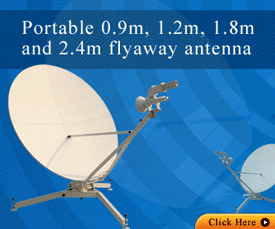VSAT Satellite Communication Systems Introduction
Satellite beam coverages
The Africa satellite beam coverage map to the right is an example of a VSAT coverage area. In this case the yellow area is the SOUTH EAST ZONE beam from the satellite operating in C band with circular polarisation. There is a similar C band with circular polarisation beam covering Europe on the same frequencies. Covering the entire area (and bounded by the red line) is a pale green area which is the EAST HEMI beam which also operates in C band with circular polarisation. It uses the opposite polarisation to the zone beams. So overall, the same frequencies are used 3 times in the satellite - once for the NE Zone, once for the SE Zone and E hemi. Use of C band is ideal for areas with heavy rain. Use of circular polarisation is important in equatorial regions where ionospheric Faraday rotation occurs, which causes severe interference in linear polarised systems. Typical C band dish sizes are 1.8m, 2.4m, 3.8m. Doubling the dish area halves the power you need from the satellite and should achieve big cost savings on your monthly charges. If you are a town ISP it is generally better to spend more on the dish and save on the monthly charges.
Smaller Ku band spot beam are provided by many satellite and enable smaller dishes to be used by customers.
If your organisation requires a number of remote users to have data access to a central hub then a VSAT satellite communications network is worth considering.Ts are suitable for both point to point networks and mesh networks. Point to point networks may be used to link small ISPs to the internet backbone.
Star network to many individual end users
A typical star network comprise 100 small remote VSAT antennas (1.2m diameter) located on customer offices scattered over Europe providing data communications via a large central 11m hub antenna. A landline optic fibre data link connects the hub antenna to the customer head office. The hub antenna and the VSATs are owned, operated and maintained by a VSAT service provider who provides a communication service to the customer company. The VSAT service provider leases satellite capacity from a satellite operator. The VSAT service provider will normally have a number of customers, thus sharing the hub costs (capital expense and staff costs) and satellite lease costs. One hub antenna might thus serve several thousand VSAT antennas.
Star trunk network (point to point links) to local community ISPs
Direct satellite to the end user is too expensive for many people and in such cases the VSAT terminal needs to be considered as a local community node, internet cybercaf, mini-ISP, town-ISP, village-ISP etc, linked either with ethernet cables for several PCs locally or via wireless network to the local community.
VSAT applications
Possible VSAT applications include: point of sale, Internet access, file distribution, database access, environmental monitoring, police, customs and excise offices. Capacity is not a problem with both very small to very large networks all viable. Growth is possible in small steps thus keeping costs related to actual use. VSAT systems provide a both data and, if required, voice services. Voice or data services with the possibility of communication between all sites (i.e. in mesh mode connection) requires slightly larger antennas and/or transmitter power amplifiers. Mesh networks may be attractive for telephony applications such as remote industry, hotel chains, bases, exploration, disaster, emergency relief etc.
VSAT systems are attractive where the coverage area is large, where quick installation is required and where terrestrial alternatives are difficult to organise.
ionospheric Faraday rotation occurs, which causes severe interference in linear polarised systems. Typical C band dish sizes are 1.8m, 2.4m, 3.8m. Doubling the dish area halves the power you need from the satellite and should achieve big cost savings on your monthly charges. If you are a town ISP it is generally better to spend more on the dish and save on the monthly charges.
Smaller Ku band spot beam are provided by many satellite and enable smaller dishes to be used by customers.
Satellite internet terminals
General purpose VSAT terminals are now becoming common. These essentially provide broadband internet access and allow web browsing and emails. Costs can be quite low if your burst speed bit rate capacity is shared with many other terminals using the same satellite capacity. For example 30 VSATs may all share the same 512k down / 64k up capacity. This works fine for internet browsing but is unsuited to Voice calls or video streaming which would cause congestion. If VoIP is required then higher monthly cost dedicated continuous information rate (CIR) service is preferred.

